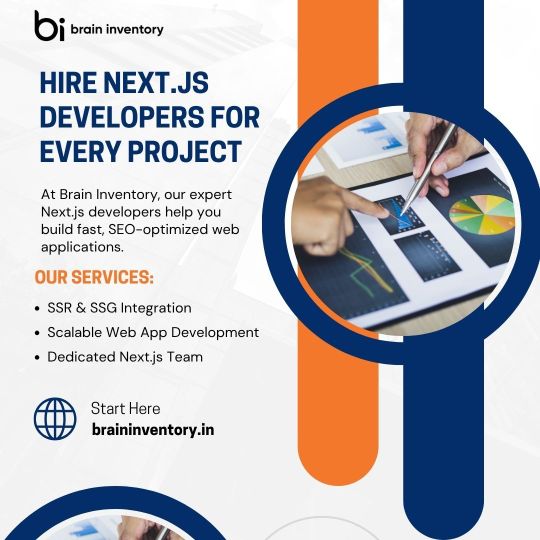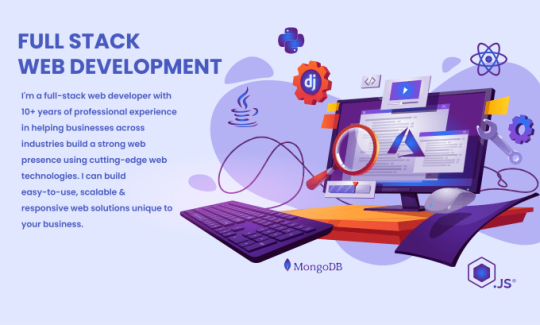#Next js
Explore tagged Tumblr posts
Text
#digital aptech#reactjs#javaprogramming#javascript#coding#react.js#next.js#next js#reactjs development company#reactjs development services#reactjs developers#web development#app development#mobile app development#next.js development company
2 notes
·
View notes
Text

Hire Next.js Developers for Lightning-Fast Sites
Build fast, SEO-optimized apps with top Next.js talent. Hire developers who deliver scalable, modern web experiences.
#Hire Next.js Developers#hire nextjs programmers#hire nextjs development company#hire dedicated nextjs developer#next js
0 notes
Text
Pros & Cons of Using RSC in Enterprise Applications
As enterprises continue to push for faster, more scalable, and efficient web solutions, React Server Components (RSC) have emerged as a compelling architectural choice. This modern approach helps balance performance and interactivity by rendering selected components server-side while keeping the client bundle lightweight.
But is RSC the right fit for enterprise-grade applications? Let’s explore its key pros and cons and how Next.js enhances its capabilities.

Pros of React Server Components
Reduced Bundle Size
Server components do not ship any JavaScript to the client. This means your client-side bundle remains smaller, translating into faster load times.
Improved SEO & Web Vitals
RSCs render HTML on the server, which is excellent for crawlers and SEO. Combined with Next.js’s rendering optimizations, your app can deliver near-instant first-paint performance.
Seamless Data Fetching
RSC enables colocated data fetching, so enterprise apps that rely on complex APIs benefit from centralized logic on the server side.
Enhanced Scalability
By decoupling data-heavy operations from client interactions, RSC makes it easier to build scalable applications, particularly for enterprises managing multiple teams and modules.
For example, when building Multilingual Websites with Next.js, server components can fetch locale-specific data without bloating the client.
Cons of React Server Components
Learning Curve
RSC introduces new concepts and architectural patterns that may require a learning period for developers used to traditional React.
Limited Interactivity
You cannot use hooks like useState or useEffect in RSCs, as they don’t run in the browser. This limits interactivity unless complemented with client components.
Tooling & Ecosystem Still Evolving
As of now, RSC is still stabilizing. Some third-party libraries and devtools may not yet fully support this paradigm.
Example: Hybrid Rendering with Next.js
JavaScript XML
// app/components/ProductList.server.jsx
export default async function ProductList() {
const res = await fetch('https://api.example.com/products');
const data = await res.json();
return (
<ul>
{data.map(product => <li key={product.id}>{product.name}</li>)}
</ul>
);
}
This server component fetches data without adding to the client-side bundle.
Should Enterprises Use RSC?
The decision comes down to team experience, scalability needs, and performance goals. For companies dealing with global reach, speed, and complex data flows, RSC can be a strategic advantage especially when coupled with the skills of next js developers who know how to blend client-server logic effectively.
Also, keep in mind that Why ReactJS Developers are in Demand is closely tied to the growing popularity of modern rendering methods like RSC, SSR, and SSG.
Final Verdict
React Server Components open the door to scalable and performant enterprise-grade applications. When used correctly within the Next.js ecosystem, they offer measurable SEO and UX gains. However, they do come with constraints that your dev team must be ready to handle.
0 notes
Text

🚀 We're Hiring! Full Stack Engineer | Pune / Hybrid
Are you a passionate developer ready to make an impact? Join our dynamic, agile team at a leading service-based company and work with cutting-edge tech like Spring Boot, Next js, Docker, Kubernetes & more!
What You'll Do: ✅ Manage change releases & application lifecycle ✅ Debug, test and secure web applications ✅ Collaborate in a Scrum team ✅ Optimize performance with our SRE team
What We’re Looking For: 🔹 Strong full-stack dev skills (Java, TypeScript, REST, etc.) 🔹 Experience with PostgreSQL, MySQL or Oracle 🔹 Familiar with CI/CD, testing and Agile workflows 🔹 Excellent communication in English
🌟 Enjoy a stimulating environment, continuous learning and hands-on work with modern devops tools.
📧 Apply Now: Send your resume to [email protected]
#Hiring#FullStackEngineer#SoftwareJobs#TechCareers#PuneJobs#Java#TypeScript#Docker#Agile#SRE#Next js#JobAlert#NowHiring#SuntelGlobal#suntelglobal#HiringAlert#JobOpening#JobVacancies#Vacancy#JobOpportunity#JobSeekers#JobInterview#HiringNow#CareerOpportunity#JobsAvailable#ApplyNow#JobSearch#Recruiting
0 notes
Text
youtube
33 - PayPal Payment Integration - Step By Step [Next js 15, React 19, PostgreSQL , Prisma, ShadCN, PayPal, Stripe API integration] 🔥🔥 Free Source Code 🔥🔥 ---------------------------------- In this Session we'll be implementing PayPal payment integration
#youtube#nodejs#programming#angular#developer#softwarecompany#education#react#webdeveloper#tech#next js#react js
0 notes
Text
Eye to the Future: Powering Full-Stack Excellence with Java and React!

At Eye to the Future, REST API integration with a Java backend and a React frontend is a smart way to build modern, scalable, and efficient web applications. For a Java React developer, the backend, often powered by frameworks like Spring Boot, manages HTTP requests, routes, and data processing, ensuring secure and optimized responses. The frontend, built with React, connects seamlessly to these APIs using a component-based approach and hooks like useEffect to fetch and display data dynamically. This setup separates responsibilities, where the backend handles the data and the frontend focuses on user experience and presentation. JSON acts as the common data format, enabling smooth communication between the backend and frontend. Tools like Axios or the Fetch API in React make API calls easy, while handling errors and loading states ensures the application feels polished. Combining Java's backend strength and React's interactive frontend creates an end-to-end solution suitable for everything from small projects to large systems. With this robust integration, developers can easily adapt the skills to work as Next.js developers, bringing scalability and flexibility to any project.
0 notes
Text
Day 259 of Code: Getting Back on Track
It’s hard to believe it’s been 106 days since my last blog post on Day 153. I know, I know – it’s a long time to go without updating my progress. But to be honest, it’s tough to balance learning to code with writing about it. Sometimes, one has to take priority over the other, and unfortunately, my blogging habit took a backseat. However, that doesn’t mean I haven’t been coding. In fact, I’ve…

View On WordPress
#algorithms#coding challenges#coding journey#learning to code#mern stack#next js#oop programming#php#programming concepts#typescript#web development
0 notes
Text
Incerro Partners with Sanity to Accelerate Scalable Digital Solution Development
Introduction Incerro, a leading front-end agency and digital solution developer, is thrilled to announce its strategic partnership with Sanity, the modern headless CMS platform. Together, we are poised to redefine digital experiences. https://www.incerro.ai/insights/incerro-partners-with-sanity
#coding#sanity#partner#programming#software engineering#startup#application development#website development#front end development#website#software#next js#web design agency
0 notes
Text
Ajit Kumar : Web Developer | Laravel Developer | Php Developer | Next Js
Ajit Kumar : Web Developer | Laravel Developer | Php Developer | Next Js
0 notes
Text
https://selfgrowth.com/articles/angular-vs-nextjs-comparison
Make an educated choice between Angular and Next.js for your upcoming project by understanding their respective advantages and limitations through our in-depth comparison.
0 notes
Text



spreading hermitcat propaganda
#lmk who i should catify next heh#i js like kitties ☹️#this was rlly all a ploy to draw more mumbo kitty#hermitcat#hermitcraft#hermitblr#mumbo jumbo#grian#goodtimeswithscar#fanart#artist on tumblr#iveoy-art#waffle duo#desert duo#hermitcats
6K notes
·
View notes
Text

I excel in swift web development utilizing the Django framework, React, Redux, Next.js, and Angular. Over the experience of 9 years, I have honed my skills working extensively with Python, Django framework, Django Rest framework, and various other Python-based technologies. My proficiency extends to comprehending SQL databases, REST APIs, and implementing robust security measures.
0 notes
Text
Hire Dedicated Next.jsDevelopers for Fast and SEO-Friendly Apps
Leverage the power of server-side rendering and seamless performance—hire expert Next.js developers for your web projects today.
For More Informationn Visit :-
#Hire Dedicated Next.jsDevelopers#hire dedicated nextjs developer#hire nextjs development company#next js#hire nextjs programmers
0 notes
Text
Why Headless WordPress + Next.js is a Future-Proof Solution
As digital experiences become more dynamic and omnichannel, the need for a flexible, high-performance web architecture is more critical than ever. One powerful combination that has emerged is Headless WordPress with Next.js, a future-proof stack that bridges the ease of content management with the performance of modern frontend frameworks.

Whether you’re building a blog, corporate site, or complex eCommerce solution, this pairing gives you the scalability and control you need for the long run.
Why Go Headless?
Traditional CMS platforms like WordPress come with tight coupling between frontend and backend, which can be limiting in terms of performance, SEO, and flexibility. With a headless CMS setup, WordPress acts as a pure content backend, while Next.js handles the frontend rendering.
When it comes to online stores, combining WordPress with modern frontend solutions delivers the benefits of eCommerce CMS better UI/UX, enhanced performance, and seamless integration across sales channels.
Sample Integration: Fetching WordPress Posts with Next.js
You can easily fetch content from your WordPress site using its REST API:
Js
// lib/api.js
export async function getPosts() {
const res = await fetch('https://yourwordpressdomain.com/wp-json/wp/v2/posts');
const posts = await res.json();
return posts;
}
Then render in a Next.js page:
js
// pages/index.js
import { getPosts } from '../lib/api';
export default function Home({ posts }) {
return (
<div>
<h1>Latest Posts</h1>
{posts.map(post => (
<div key={post.id}>
<h2 dangerouslySetInnerHTML={{ __html: post.title.rendered }} />
<div dangerouslySetInnerHTML={{ __html: post.excerpt.rendered }} />
</div>
))}
</div>
);
}
export async function getStaticProps() {
const posts = await getPosts();
return {
props: { posts }
};
}
This approach allows you to build static or server-rendered sites that are lightning fast and SEO-friendly.
DevOps Bonus: Automate with CI/CD
Maintaining performance and deployment consistency is key. Automating builds via GitHub Actions ensures smooth rollout. If you're new to it, here’s a handy guide on CI/CD Pipelines for Next.js Projects with GitHub Actions.
When to Hire Experts
Implementing a headless architecture can be technically demanding. If you want to streamline development, performance optimization, and integration, it’s smart to hire Next.js developers who are experienced with CMS and modern web standards.
Final Thoughts
Combining Headless WordPress with Next.js is more than a tech trend it’s a strategic move toward speed, security, and scalability. With a modern CMS on the backend and a performance-first frontend, your digital product is ready for the future.
0 notes
Text
Dynamic and Responsive Web Applications with Next.js and Mongoose
In the fast-paced realm of web development, the ability to create dynamic and responsive applications is a critical skill. This blog post will guide you through the process of initiating a project using Next.js, a popular React framework, paired with MongoDB and Mongoose for robust database management. By the end of this guide, you'll have a solid foundation to propel your web application towards success.
Key Features:
Server-Side Rendering (SSR):
Next.js excels in server-side rendering, generating pages on the server before reaching the client. SSR enhances performance, boosts SEO, and ensures a smoother initial loading experience for users.
Static Site Generation (SSG):
Leveraging Next.js, static site generation pre-builds pages at compile time, serving them as static files. Ideal for content-heavy websites, this approach ensures swift loading times and efficient caching.
API Routes:
The ability to create API routes directly within your project simplifies the development of serverless functions and backend functionality with Next.js.
CSS-in-JS Support:
Enjoy built-in support for various CSS-in-JS solutions, such as Styled Components or Emotion, making styling your components a seamless process.
Environment Variable Support:
Next.js supports the use of environment variables for configuration, allowing you to manage different settings across development, staging, and production environments.
Mongoose Introduction:
Key Features:
Schema Definition:
Define a schema for MongoDB documents using Mongoose, creating a clear structure for the data. Schemas specify the data's shape, including field types, default values, and validation rules.
Data Validation:
Mongoose incorporates built-in validation, ensuring documents meet specific criteria before being saved to the database. Apply validation rules to individual fields for robust data integrity.
Middleware:
Mongoose supports middleware functions, enabling custom logic before or after events like saving a document or querying the database. Middleware is a powerful tool for encapsulating business logic within your models.
Query Building:
Simplify the creation of complex MongoDB queries with Mongoose's fluent API. Build queries effortlessly using methods like find, findOne, and update, streamlining interactions with the database.
Connection Management:
Mongoose efficiently manages database connections, providing a straightforward way to connect to MongoDB and handle connection events. With built-in connection pooling, resource usage is optimized.
The fusion of Next.js and Mongoose streamlines web development, facilitating efficient, scalable applications. Leveraging their strengths, developers craft SEO-friendly, interactive experiences with seamless data handling. This integration empowers developers to build compelling, modern applications amid evolving web development paradigms.
0 notes
Text
youtube
Next.Js 15/ React 19 - eCommerce Complete Project [PostgreSQL, Prisma, ShadCN-UI, Paypal, Stripe integration] https://youtu.be/78B6UV-Xk80
#youtube#nodejs#programming#education#developer#webdeveloper#angular#react#softwarecompany#tech#next js#react js
0 notes